*** IMPORTANT - I'm retiring my digital files - SVG/PNG/DXF/EPS - and printables from 31st December 2025 ***
*** Please ensure that you have everything you need - files and/or instructions printed off from the website (find them currently in the ARCHIVES section) - by 31st December 2025 as they will not be available after this date ***

Nature Journaling Autumn Fungi & Folklore
- Home
- Nature Journaling
- Nature Journaling Autumn Fungi
Nature journaling autumn fungi, with folklore and art - discover how nature journaling helps you slow down, notice more, and reconnect with the season...
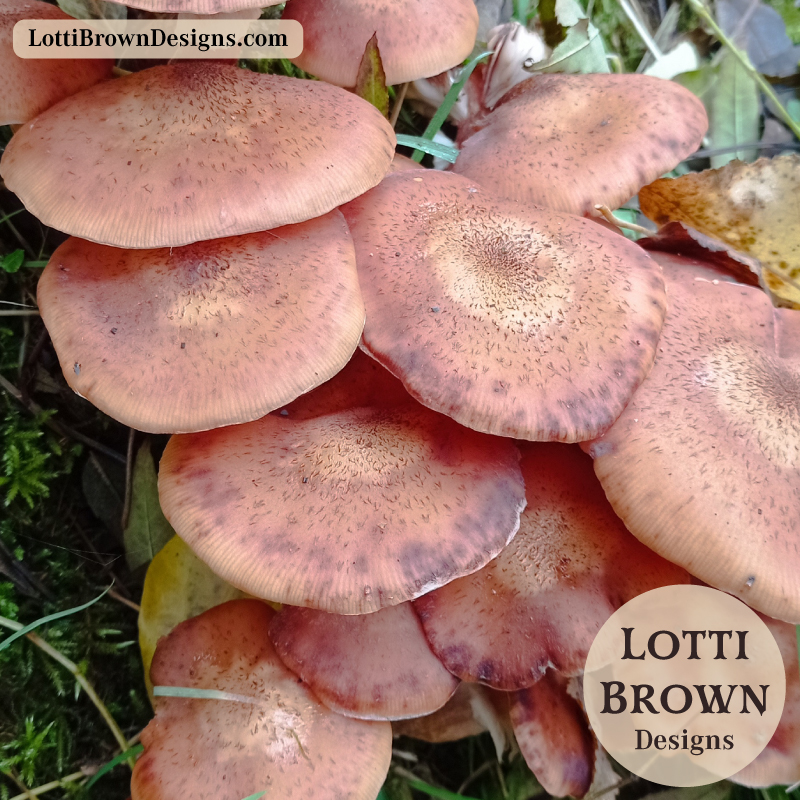 Morning light in the October woods, where fungi rise quietly from the damp earth
Morning light in the October woods, where fungi rise quietly from the damp earthNature Journaling Autumn Fungi

In October, my daily morning walks feel different. The early morning light has a gentle blue cast, and the air feels cool against my face while wet grasses soak my walking boots (and the bottom of my trousers) as I walk through the fields and woodlands. The cawing of crows seems to echo softly all around - a sound that feels ancient, part of the season.
This is the time of year when the world begins to turn inward, when hidden things start to reveal themselves. Nature journaling in autumn teaches me to look closer, to find wonder in unexpected places - the damp earth of field verges, the bases of trees, and mossy logs. This is where I discover the often-overlooked messengers of the season - fungi.
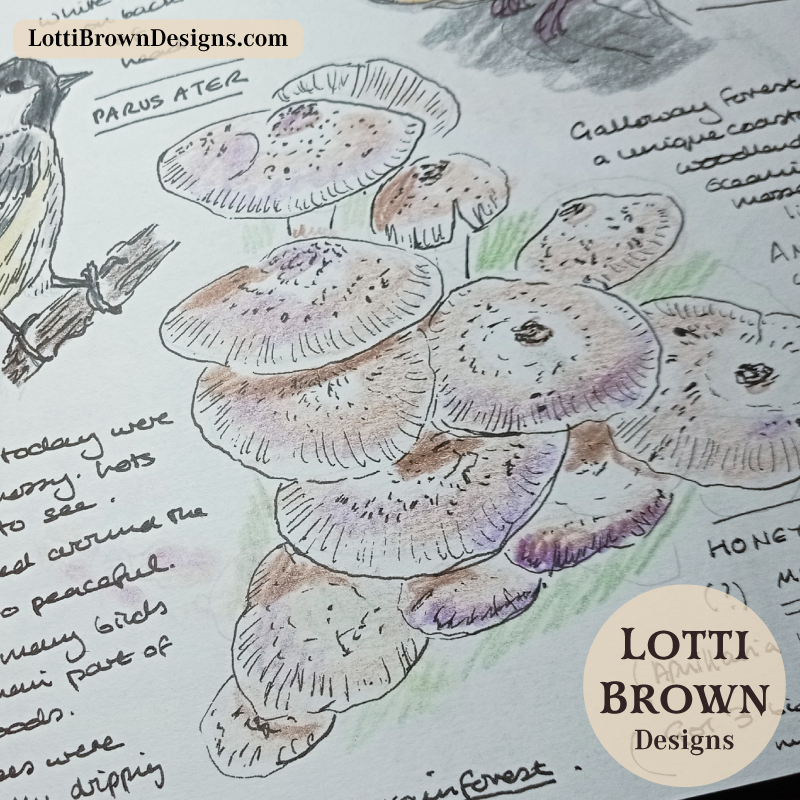 My October nature journal - fungi sketches, folklore notes, and quiet observations from the woods
My October nature journal - fungi sketches, folklore notes, and quiet observations from the woodsFungi are the visible part of a vast underground network of mycorrhizal roots, which seem to spring to life overnight in the rainy autumn season. It’s easy to understand why people once believed mushrooms grew where lightning had struck - a spark of mystery from the heavens. In fact, there’s some truth in that old tale, as research suggests that logs struck by lightning may produce twice as many mushrooms.
Fungi are a vital part of our ecosystem, breaking down decaying matter and returning nutrients to the soil, while also feeding plants, insects, and animals. They’re part of what’s often called the “Wood Wide Web,” a natural communication system where forests share what they need to survive.
I love the idea that the forest beneath our feet is whispering - that everything is quietly connected, even when we can’t see it.
Fungi are amazing - and in British folklore, they’re most often associated with the world of fairies.
Folklore & Fairy Rings
A large circle of mushrooms in grass is called a Fairy Ring. My Grandpa had one in his garden, which we were fascinated by as children. I still remember crouching beside it, daring myself to step inside - half hoping the fairies might take me, half terrified they actually would.
According to folklore, these rings mark portals into the fairy realm - places where fairies and pixies dance at night. To step inside was said to risk being trapped forever in a purgatory between worlds, invisible to humans and fairies alike.
The Fungi I Found
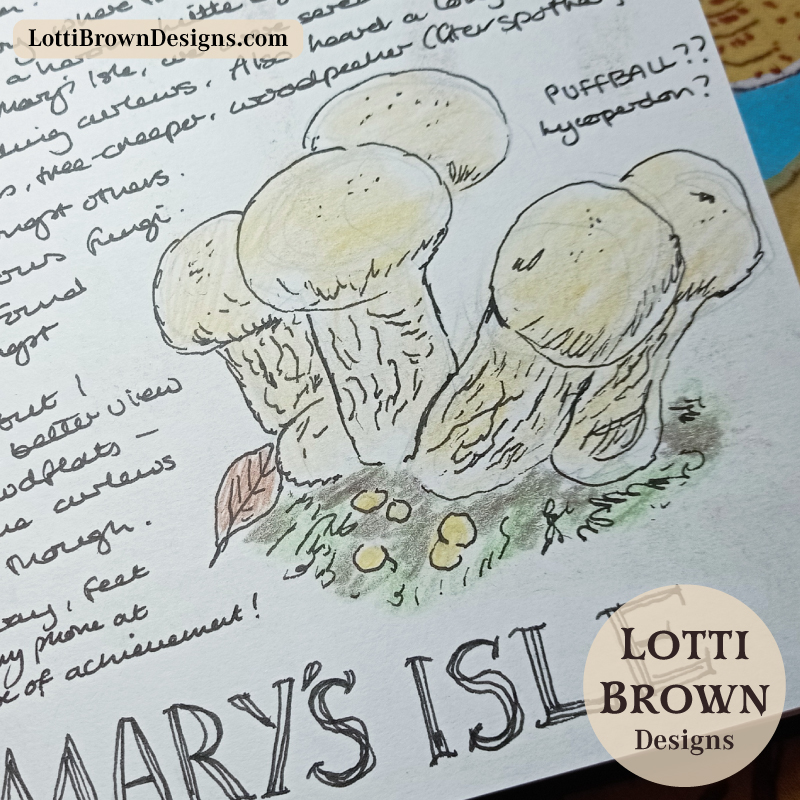 Round puffballs hiding under the trees, waiting to burst and scatter their tiny spores
Round puffballs hiding under the trees, waiting to burst and scatter their tiny sporesI found these gorgeous round puffball mushrooms (above) under trees in woodland. They looked so plump and ready to pop! When they burst, they spread their tiny spores far and wide. Medieval herbalists would use puffball powder as a styptic to stop bleeding - a small example of how nature may provide when we are most in need.
These intricate turkey tail mushrooms (below) were beautifully coloured in reds and purples, growing amongst soft green mosses on the cut ends of logs, looking just like tiny fairy steps. In folklore, their layers are thought to symbolise layers of wisdom and life cycles, connecting us to ancestral knowledge. Used in traditional Chinese medicine and medieval European remedies, they were valued for healing, both physical and spiritual.
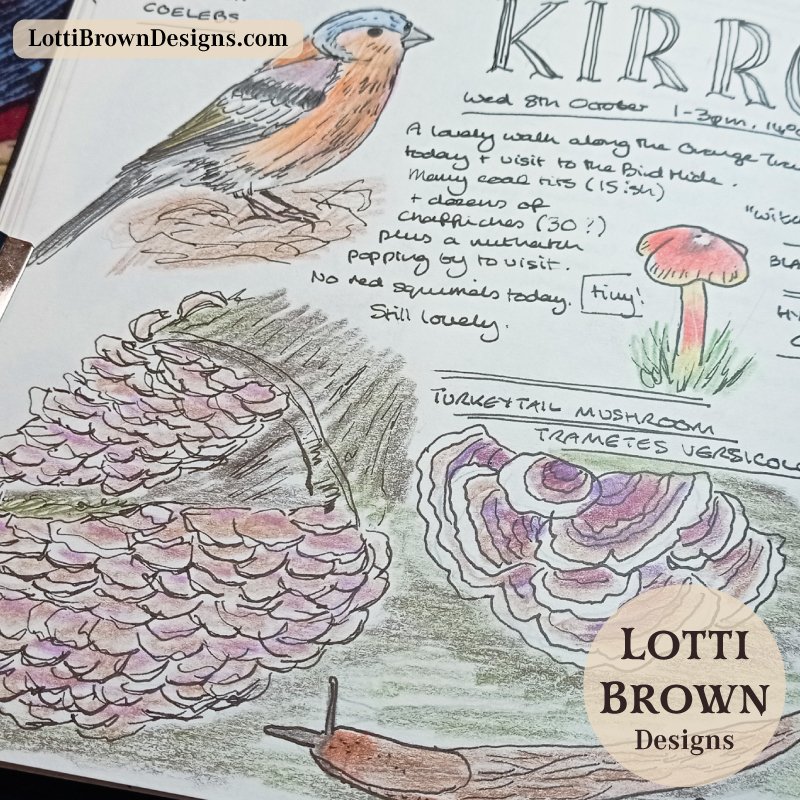 Turkey Tail mushrooms layer like tiny fairy steps on the end of the log and a tiny red Witches’ Hat mushroom (Blackening Waxcap) is spotted in the grass
Turkey Tail mushrooms layer like tiny fairy steps on the end of the log and a tiny red Witches’ Hat mushroom (Blackening Waxcap) is spotted in the grassAnd then, tucked away in the grass, I spotted a single tiny Witches’ Hat mushroom (above) - a bright red cap that slowly darkens into black. It’s easy to see how mushrooms became linked to witches and warnings in folklore. Misidentifying a species could be deadly, so mushrooms became symbols of danger and forbidden knowledge.
One of my favourite finds was the Shaggy Inkcap (below), also known as the ‘Lawyer’s Wig’. Historically, ink was made from inkcap mushrooms. As the edges of the inkcap mushroom curl up and dissolve, they form a pool of black liquid perfect for writing. Important documents were once signed with inkcap mushroom ink - the unique spore pattern was able to prevent forgeries.
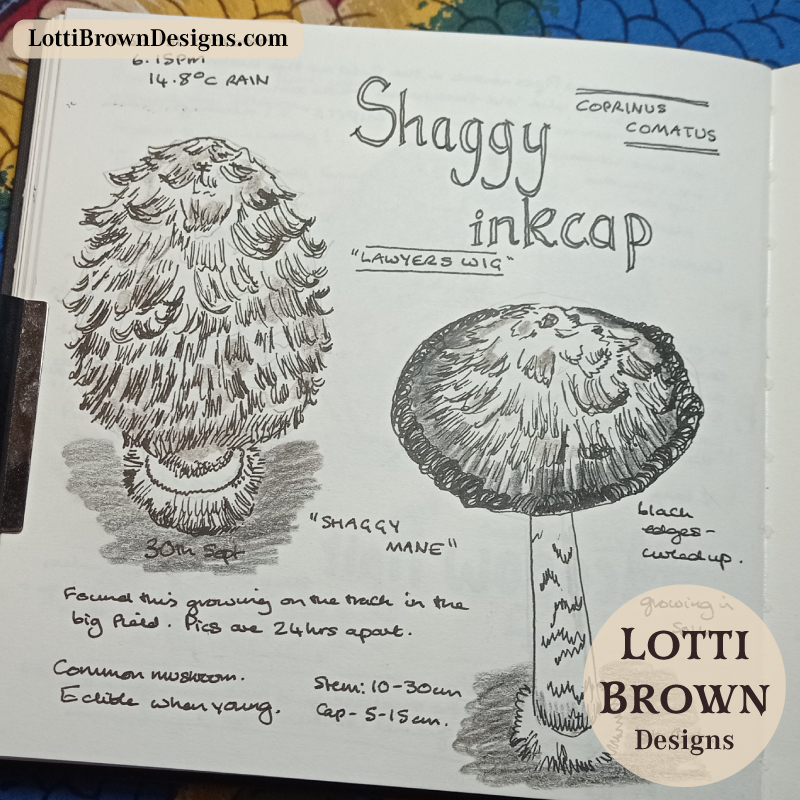 The Shaggy Inkcap (Lawyer's Wig) mushroom is nature’s own inkwell, once used to make writing ink from its dissolving dark edges
The Shaggy Inkcap (Lawyer's Wig) mushroom is nature’s own inkwell, once used to make writing ink from its dissolving dark edgesI also loved discovering the tiny Pleated Inkcap (below), sometimes called the ‘morning mushroom’ for its very short life cycle. It looks just like a delicate paper parasol, perhaps a fairy’s umbrella left behind after a midnight dance.
The Common Inkcap mushroom (below) is also known as ‘Tippler’s Bane’ or ‘Alcohol Inky Cup’ as these became extremely toxic if alcohol was drunk within a few days either side of eating the mushroom.
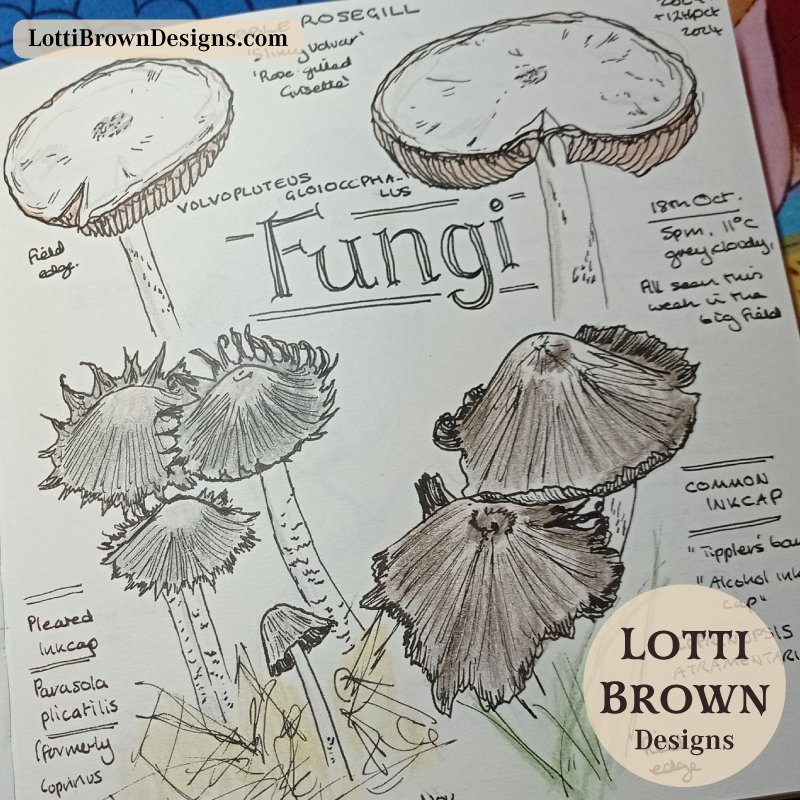 Pleated Inkcap mushroom (Japanese Umbrella), with Common Inkcap mushroom (Tippler's Bane) and Stubble Rosegill mushrooms, drawn in my nature journal
Pleated Inkcap mushroom (Japanese Umbrella), with Common Inkcap mushroom (Tippler's Bane) and Stubble Rosegill mushrooms, drawn in my nature journalI’ve really appreciated looking more closely at fungi this autumn. There seems something humbling about them - they live most of the year unseen in darkness, waiting for just the right moment to emerge and transform decay into new life.
Drawing them in my nature journal, I realised fungi are like us - quietly doing the work of renewal. They remind me that growth can begin in dark places, that transformation might be hidden for a while, and that, in time, even the smallest of us can strengthen, and connect with the world around us.
Ideas for Your Nature Journaling in Autumn
If you’d like to explore fungi in your own nature journaling this autumn, here are a few gentle ideas to begin:
- Take a walk after rain and look closely near tree roots, on fallen logs, or in grassy verges
- Sketch shapes and colours - they’re more varied than you might think
- Note where you find them - the light, the weather, what you could hear and see
- Write a few lines about how you felt in that moment, or research some folklore connected to your find
Nature journaling doesn’t have to be perfect. It’s about being present and curious - one small wonder at a time.
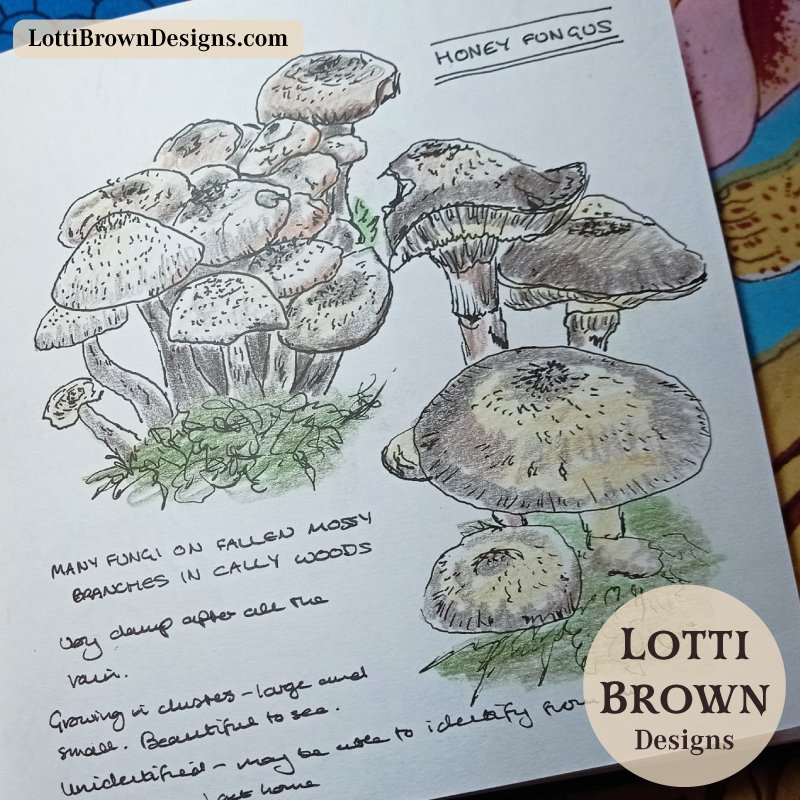 The woods grow quiet for winter, but the fungi remind me that even in darkness, life blooms unseen
The woods grow quiet for winter, but the fungi remind me that even in darkness, life blooms unseenSoon the woods will quieten in the cold of winter, but for now, the fungi bloom, reminding us that even the darker months hold their own quiet beauty.
Perhaps that’s why I love drawing fungi - they remind me that magic still breathes in the damp soil and shadowy places. You have only to pause long enough to see it.
If you’d like to keep exploring nature and creativity, you can join my monthly newsletter (see the sign-up box below) for gentle inspiration, seasonal reflections, and a peek inside my sketchbook.
Or, if you’d like to start your own journey, my Imperfect Nature Journaling course offers 20 simple, creative exercises to help you begin noticing and sketching nature in your own way.
However you choose to start, I hope your next walk brings a moment of stillness, and who knows, maybe even a little fungi magic?
You can keep exploring more nature journaling ideas on this page... or discover the fungi that caught my eye last October here...
If you'd like to see more of my British nature folklore content, take a look on this page...
Please remember that mushrooms and fungi are notoriously difficult to identify, and some species are deadly, so err on the side of caution if you decide to handle them.
Nature Journaling Course
 Downloadable PDF nature journaling course - 120+ pages, 20 exercises
Downloadable PDF nature journaling course - 120+ pages, 20 exercisesIf you'd like to explore nature journaling more, please consider joining me for my 'Imperfect Nature Journaling' online course - I've called it this to remind us to nature journal for the process of connecting with nature to feel good and not to put pressure on ourselves to create pretty pages which can quickly ruin the fun and the benefits...
It's a series of 20 lessons (in downloadable PDF format) which are great exercises that you can do in your own nature journal to help you try out different ideas and techniques.
This will help you get the most out of your nature journaling sessions and understand what style of nature journaling is the best for you personally.
If this sounds like something you might like, you can find out more about the course here...
Shall we stay in touch..?
Each month, I share stories from my own nature journal, new art from my studio, and simple seasonal inspiration to help you feel more connected with the turning year...
Recent Articles
-
British Nature Folklore Library: Stories, Seasons & Celtic Tree Wisdom
Dec 01, 25 05:09 AM
Explore British nature folklore, Celtic tree meanings, and seasonal wildlife stories. A growing library of myth, meaning, and hand-drawn inspiration. -
Beautiful Art Inspired by Nature
Dec 01, 25 05:04 AM
Beautiful folksy art inspired by nature from the fields and hedgerows of Yorkshire - colourful birds and wildlife with a nostalgic floral touch... -
Birds and Folklore in Britain: A November Nature Journal
Nov 26, 25 04:32 AM
November birds and berries - fieldfares, redwings, lapwings and snow geese with folklore, meaning and nature journal inspiration.
Follow me:
Share this page:




